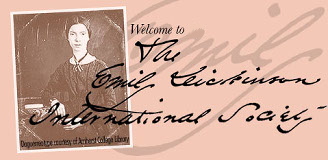
You are hereWhy Didn’t Dickinson Publish?
Submitted by Guest (not verified) on July 19, 2011 - 11:19am
This space is open to all EDIS members to share information about conference themes. Members can edit the page and comments are enabled. To make a comment, use your login and password. Enjoy the discussion!
|
Comments
Why didn't Dickinson publish?
One way of thinking about this might be to ask what we mean when we say that Dickinson didn't publish. What do we mean? What does it mean that she circulated so many of her poems in letters?
So Did She, Didn't She? What Other Questions Can We Ask?
Is "publication an insult to any writer"?
Did she engage in self-publication? What about the circulation of writings during her time?
What are the distinctions between "publish" and "print"?
Karen Dandurand is beginning to fill in the historical context of Dickinson and printing. Up through the 1970s, the prevailing critical view was that Dickinson really wanted to publish but the editors of her time did not want her to do so. This was an anachronistic view, with twentieth-century framings. In this, the sense was of "poor Emily." Since the 1970s, the prevailing view has been that she CHOSE not to publish. Now she is discussing her discoveries of poems that were printed during Dickinson's lifetime and posits that Bowles simply published a poem that she had given him without her permission. Dandurand is talking about printings in the Drum Beat, the Brooklyn Daily Union, and other newspapers. She's also talking about Higginson's urging young writers not to rush things into print.
Dandurand asserts that Dickinson wanted to avoid fame, which has quite a high price in terms of privacy, control of time, and what Higginson called "consciousness."
Publishing and Printing, a new Kind of Literary Celebrity
Mike Kelly picks up on Dandurand's comments. Within Dickinson's lifetime, there was a tremendous change in scale in terms of what it meant to publish--Uncle Tom's Cabin sold more than 400,000 copies in the U.S. and even more when published abroad. Thus a new notion of literary celebrity emerges. Writers were going around giving lectures. Did Dickinson want to engage with the full machinery of literary celebrity. Graham's Magazine offered Longfellow and Bryant $50 for one poem a month. So writing to someone else's schedule was probably something else she did not like. Her first experience of publication was her brother Austin and his friends publishing their own magazine, so subversive and outside the conventional mechanisms of publication.
Dickinson Did Not "Publish" Because She Had a Room of Her Own
Trisha Kannan believes that Dickinson did not publish because she had a room of her own. Reading all 40 fascicles completely changed her image of Dickinson--how did the "Myth" Kannan learned about in high school come to be? That "Myth" could not assemble those books. Publication was not foreign to her thought. Making the 40 manuscript books, Dickinson was aware that context changes everything. The manuscripts were a placeholder for a future public and here we are now. We're in a new age of fascinating questions.
Didn't Dickinson Publish?
Seth Perlow--"didn't Dickinson publish?" Construction of a public is still a very lively, relevant question. Coterie poetics--how do we understand those? How do we understand anonymity? How does it shape the reception of a poem? How didn't Dickinson publish? What does it mean to choose not to publish, if that's the case? If we're talking about the vocabulary we use for thinking about Dickinson's relationship to the possibility of publication--"passive availability," a phrase he just used has, by his own assessment, certain gendered connotations that he's not comfortable invoking. She was attentive to the openness of the future--"passive availability" to futurity and its possibilities (Susan Howe).